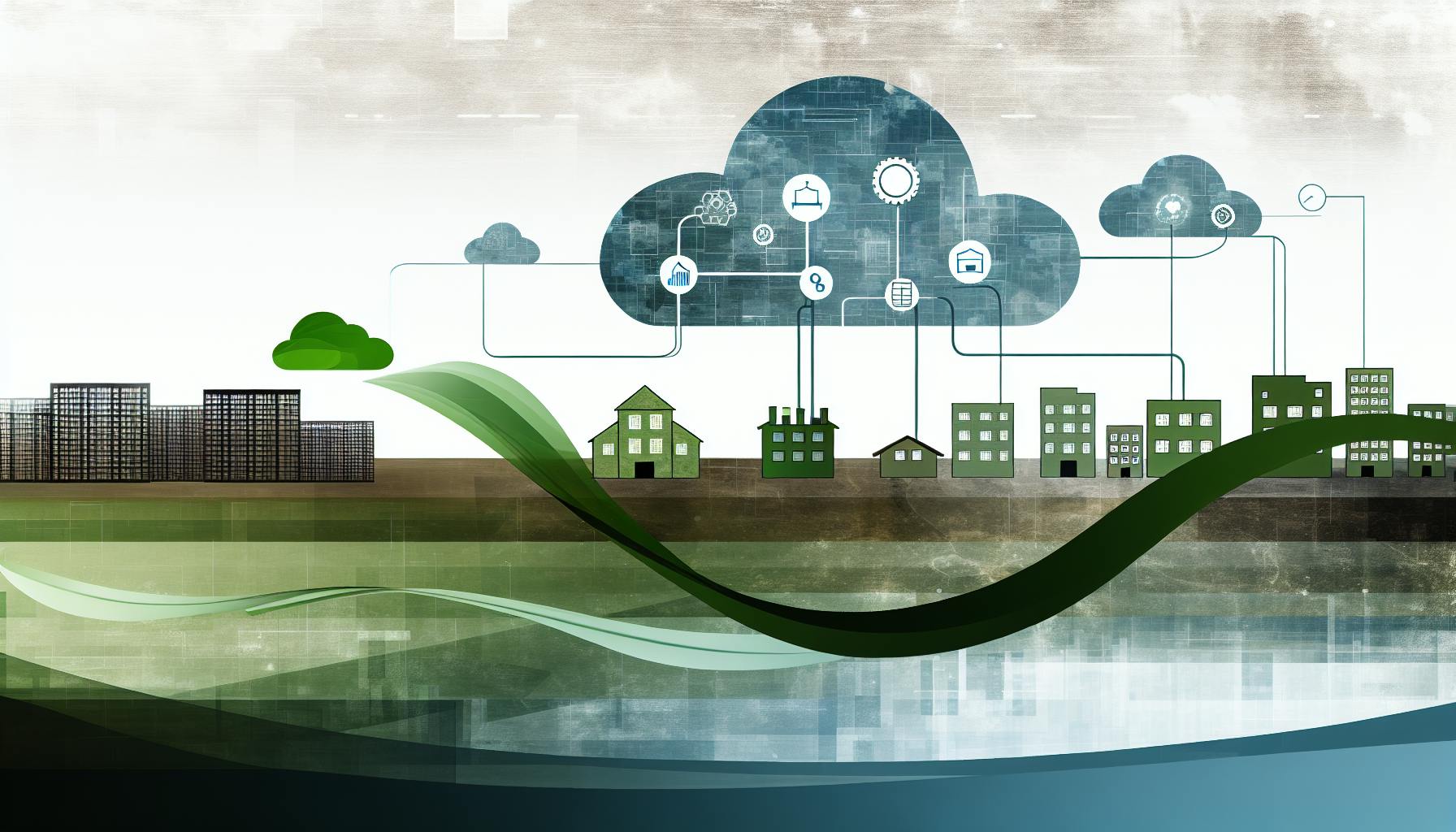Most business owners will agree that carbon accounting seems complicated and resource-intensive.
But it doesn't have to be. With the right approach, SMEs can streamline carbon footprint accounting to drive meaningful climate action.
In this post, we'll demystify the complexities of GHG accounting - breaking down key concepts and outlining straightforward strategies to help SMEs measure and reduce emissions effectively.
Introduction to Carbon Footprint Accounting
Carbon footprint accounting refers to the process of measuring greenhouse gas (GHG) emissions from business operations. For small and medium-sized enterprises (SMEs), tracking carbon emissions is becoming an essential practice to meet environmental standards and regulations. Done right, it can also uncover opportunities to innovate processes and reduce costs. This guide covers the basics of carbon accounting tailored for SMEs.
Demystifying Carbon Accounting for SMEs
In simple terms, carbon accounting involves adding up all the greenhouse gases that get released into the atmosphere from your company's activities. This includes direct emissions from owned or leased facilities and vehicles, indirectly from purchased electricity and heat, as well as other indirect sources along your value chain.
To calculate your carbon footprint, you'll need to measure and convert emissions data (e.g. liters of fuel burned, kilowatt-hours of electricity used) into a standard unit - carbon dioxide equivalent (CO2e). This represents the global warming potential of each different GHG (methane, nitrous oxide) in terms of the equivalent amount of CO2.
For example, a small manufacturer might track natural gas and diesel consumption at its factory, business travel, and emissions from waste to estimate annual CO2e emitted. An accounting firm would calculate emissions from purchased electricity, employee commutes, and more.
Ideally, carbon accounting follows recognized standards like the Greenhouse Gas Protocol to ensure consistent and accurate footprint calculations that are credible to regulators and stakeholders.
The Relevance of GHG Accounting in Business
Going beyond legal compliance, understanding your carbon footprint through GHG accounting can reveal plenty of "win-win" opportunities for SMEs to cut costs and future-proof operations.
For instance, analyzing emissions data can spotlight energy waste and inefficiencies to target for reduction. Streamlining logistics, optimizing processes, even influencing employee and supplier behavior can drive down carbon footprint significantly while boosting productivity and profitability.
Moreover, as sustainability becomes increasingly important to investors, customers and talent, the ability to credibly report and engage around your emission reduction efforts offers valuable reputational benefits. It signals that your SME is environmentally conscious and future-fit to evolve in a low-carbon economy.
In summary, carbon accounting is not just a box-ticking exercise but a chance to embed climate responsibility within business strategy - in a way that works for smaller enterprises too. When done effectively with the right solutions, the payoffs for your bottom line and environment can outweigh the effort required.
How do you record your carbon footprint?
Collecting the necessary data is an essential first step when attempting to measure your carbon footprint. This involves tracking key metrics across various aspects of your business operations.
When recording emissions data, it's important to use standardized units to enable accurate accounting and benchmarking. Some guidelines on data collection include:
Energy Use
- For electricity purchased and consumed onsite, record kilowatt-hours (kWh) from utility bills or smart meters. This provides the most precise measurement.
- For other onsite fuel combustion like natural gas, diesel, gasoline, etc., record fuel volumes in liters or kilograms purchased over a given time period. Heat content and emissions factors can then be applied to estimate emissions.
Transportation
- For company-owned vehicles, record actual fuel consumption data from purchase receipts or vehicle logs. This provides the most accurate emissions data.
- For employee commuting and business travel in personal or rental vehicles, estimates may need to be made based on mileage logs and standardized fuel efficiency data.
Purchased Goods & Services
- Work with suppliers to request emissions data associated with goods and services purchased. This includes emissions from raw material extraction, production, transportation and delivery.
- Where supplier data is unavailable, secondary data sources can be used to model emissions based on spend. However industry-specific data is preferred for accuracy.
Careful data collection following standardized approaches is key to developing a robust carbon footprint baseline. With reliable data in hand, you can then identify hotspots, set reduction targets, and track performance over time. Reaching net-zero requires what gets measured to truly get managed.
What is the difference between GHG accounting and carbon accounting?
Although the terms carbon accounting and GHG (greenhouse gas) accounting are sometimes used interchangeably, there is an important distinction between the two when it comes to measuring a company's environmental impact.
Carbon Accounting
Carbon accounting specifically focuses on measuring carbon dioxide (CO2) emissions generated from business operations and the supply chain. As carbon dioxide makes up the largest share of greenhouse gas emissions for most companies, carbon accounting provides a snapshot of a significant portion of a business's climate footprint. This involves calculating emissions from sources like facilities, company vehicles, business travel, purchased electricity, and more.
GHG Accounting
GHG accounting takes a more comprehensive approach by measuring all seven greenhouse gases covered under major reporting protocols like the Greenhouse Gas Protocol Corporate Standard. Along with CO2, this includes methane, nitrous oxide, hydrofluorocarbons, perfluorocarbons, sulfur hexafluoride, and nitrogen trifluoride. While more complex, tracking all gases provides greater visibility into total climate impact.
By taking into account the broader range of greenhouse gases, GHG accounting offers a more complete view of an organization's contribution to global warming. However, for many small and medium enterprises, focusing first on carbon accounting can provide a solid foundation for sustainability management. As climate reporting matures, expanding the scope to full GHG accounting enables even deeper emissions insights.
Can carbon footprint be measured by carbon accounting?
Carbon accounting is a methodology for measuring and reporting on carbon emissions produced by an organization, process, or product. By mapping out carbon sources and sinks and tracking over time, carbon accounting enables entities to calculate their overall carbon footprint.
Some key benefits of adopting carbon accounting practices include:
- Identifying the largest contributors to emissions, known as hotspots, which can then be targeted for reductions
- Setting an emissions baseline to measure progress against over time
- Complying with emerging regulations around sustainability reporting
- Meeting stakeholder demands for climate action and transparency
Carbon accounting considers all six greenhouse gases covered by the Kyoto Protocol - carbon dioxide, methane, nitrous oxide, hydrofluorocarbons, perfluorocarbons, and sulfur hexafluoride. The methodology follows the principles outlined in the Greenhouse Gas Protocol Corporate Standard, covering direct emissions from owned facilities (Scope 1), indirect emissions from purchased energy (Scope 2), and other indirect emissions across the value chain (Scope 3).
By taking a measurement-based approach, carbon accounting makes the invisible visible - empowering entities of all sizes to understand, take ownership of, and reduce their climate impacts through data-driven decisions. When implemented effectively across industries, it can accelerate the transition to a low-carbon economy.
What is the accounting standard for carbon?
The Verified Carbon Standard (VERRA) is a widely used voluntary carbon accounting standard for businesses seeking to reduce their carbon footprint.
Introduced in 2005 by the Climate Group, the International Emissions Trading Association, and the World Economic Forum, VERRA aims to provide transparency and consistency in carbon accounting practices.
VERRA is based on the accounting principles of ISO 14064 Part 2 and the Greenhouse Gas Protocol - the globally accepted standards for measuring greenhouse gas emissions. By aligning with these standards, VERRA ensures its carbon accounting process is accurate, complete, and consistent across all industries.
Some key aspects of VERRA's carbon accounting approach include:
- Quantifying all material emission sources and sinks within the company's operational boundary
- Categorizing emissions data by scope - Scope 1 for direct emissions, Scope 2 for indirect emissions from purchased energy, and Scope 3 for other indirect emissions
- Ensuring accurate measurements and calculations as per the latest IPCC guidelines
- Getting emissions data verified by an independent third-party auditor
- Publicly reporting the carbon footprint inventory on a periodic basis
In summary, VERRA provides a rigorous and transparent carbon accounting framework for businesses to quantify, report and offset their climate impact. By facilitating independent verification and bringing consistency, it builds trust and credibility around voluntary climate actions.
sbb-itb-919600f
Exploring Types of Carbon Accounting
Carbon accounting refers to the process of measuring and reporting greenhouse gas (GHG) emissions from various sources. For small and medium enterprises (SMEs), having a robust carbon accounting methodology is crucial for managing and reducing emissions efficiently.
There are a few main types and frameworks for carbon accounting that SMEs can leverage:
Diving into GHG Protocol Standards
The Greenhouse Gas (GHG) Protocol is the most widely used international carbon accounting framework. It provides standards and guidance for companies to prepare a comprehensive corporate GHG inventory.
Some key aspects of the GHG Protocol relevant for SMEs include:
- Setting organizational boundaries - Determining which operations, facilities and vehicles to include when accounting for emissions. This allows SMEs to set an appropriate scope.
- Tracking Scope 1, 2 and 3 emissions - Categorizing direct and indirect emissions into three scopes gives a complete view. Scope 3 can be especially important for office-based SMEs.
- Using primary and secondary data - Leveraging real-time data from sensors as well as reference data helps balance accuracy and efficiency.
- Following consistent methodologies - Applying consistent emissions factors and calculations allows for standardized reporting and comparisons over time.
Following GHG Protocol guidelines, even in a simplified manner, allows SMEs to account for a majority of their carbon footprint. Over time, more advanced analyses can reveal reduction opportunities.
From Calculators to Comprehensive Tools
The spectrum of carbon accounting solutions for SMEs ranges from basic calculators to extensive reports:
- Carbon calculators - Simple online tools for quick estimates based on high-level assumptions. Easy to use but less accurate.
- Hybrid models - Lite software combining calculators with some custom company data for enhanced estimates.
- GHG accounting platforms - Robust tools connecting to real-time data sources and providing detailed tracking as per GHG Protocol.
As sustainability reporting gains prominence, SMEs may need to graduate from basic calculators to more advanced carbon accounting platforms. The choice depends on internal expertise, compliance needs, reduction targets, and availability of granular data.
By understanding types of accounting methodologies, SMEs can adopt an approach that matches their resources and climate action ambitions. Investing early in scalable tools lays the foundation to expand GHG analysis over time.
Why Carbon Accounting is Imperative for SMEs
Carbon accounting has become an indispensable practice for small and medium-sized enterprises (SMEs) looking to future-proof their business. With intensifying climate change regulations, surging stakeholder expectations, and shifting market forces, measuring and reporting emissions is no longer an option but a strategic necessity.
Economic Incentives of Emission Management
Far from just a box-ticking exercise, robust carbon accounting paves the way for SMEs to uncover cost efficiencies while building resilience. By shining a light on emissions hotspots across operations, carbon budgets can be set, reduction opportunities identified, and environmental innovations sparked. The rewards speak for themselves - decreased energy expenditure, supply chain optimizations, product/service differentiation, and more.
Done right, sustainability also drives revenue growth. In a 2021 survey, 66% of consumers said they are willing to pay more for environmentally friendly offerings. And with metrics like carbon intensity playing an increasing role in procurement decisions, quantifying emissions positions SMEs to tap into these expanding markets.
Meeting Stakeholder Expectations
Transparency around climate impacts is no longer just a "nice to have" but expected of any business wanting to secure its social license to operate. From shareholders and regulators to customers and the public, stakeholders are demanding climate accountability through comprehensive emissions reporting.
Facing scrutiny from lenders and investors especially, SMEs must back up verbal commitments with robust data and reduction plans. Using recognized standards like the Greenhouse Gas Protocol builds confidence in disclosed emissions performance. Failing to measure and disclose is increasingly seen as failure to take climate change seriously.
By preemptively monitoring, managing and reporting emissions, SMEs can satisfy growing stakeholder expectations around quantifiable climate action while avoiding reputation risks.
Constructing a Carbon Accounting Report
Carbon accounting reports are essential for small and medium enterprises (SMEs) on the path to reducing their carbon footprint. These reports provide a detailed breakdown of a company's greenhouse gas (GHG) emissions from their operations and value chain. Constructing an accurate and robust carbon accounting report is crucial to understand emission sources, set reduction targets, and track progress over time.
Here are some guidelines for SMEs looking to compile a comprehensive carbon accounting report that reflects their true emission profile and reduction efforts.
Data Collection and Validation
The foundation of any carbon accounting report is high-quality emissions data. SMEs first need to identify all direct and indirect GHG emission sources across their organization and supply chain. This can include:
- Direct (Scope 1) emissions from owned/controlled operations like fuel combustion
- Indirect (Scope 2) emissions from purchased electricity
- Other indirect (Scope 3) emissions from business travel, procurement, waste disposal etc.
Once emission sources are mapped, data needs to be collected for each source and validated. Carbon footprint accounting requires following standard calculation methods and data collection principles outlined in established frameworks like the GHG Protocol.
Some best practices for SMEs during this process are:
- Partner with internal teams like sustainability, facilities management, procurement etc. to obtain accurate activity data
- Prioritize high-impact emission sources for more rigorous data collection
- Leverage emission factors from reputable databases
- Perform quality checks by cross-verifying data from multiple sources
- Clearly document all calculations, assumptions and emission factors
Following robust data validation processes improves the credibility of carbon accounting reports.
Narrating the Carbon Reduction Journey
Beyond just reporting GHG emission totals, the carbon accounting report should also narrate the SME's sustainability journey thus far and plans ahead. Strategic storytelling enables SMEs to communicate their decarbonization milestones more impactfully to both internal and external stakeholders.
Some key strategies include:
- Highlight emission reduction achievements against past performance
- Provide context on specific actions that drove emission cuts like renewable energy procurement, process improvements etc.
- Report on lead indicators that demonstrate sustainability progress despite fluctuation in absolute emissions
- Set future science-based emission reduction targets
- Describe intended activities and investments to meet those targets
Telling this forward-looking carbon reduction story with supporting data boosts stakeholder confidence in the SME's climate action plans. It transforms a carbon accounting report from a compliance document into a strategic communication tool for sustainability leadership.
In summary, SMEs can construct robust carbon accounting reports by adhering to data collection best practices for accuracy and emphasizing their GHG mitigation journey to engage stakeholders. Following these guidelines results in a credible and compelling report that reflects an SME's true commitment to reducing their climate impact.
Implementing Carbon Footprint Accounting
Adopting carbon footprint accounting can seem daunting for small and medium enterprises (SMEs), but it is an essential step towards building a sustainable business. With the right strategy and technology, SMEs can seamlessly integrate emissions measurement into operations.
Here is a practical roadmap for SMEs to roll out carbon accounting:
Setting Goals and Boundaries
The first step is determining the scope and objectives of your carbon accounting efforts. Outline specific, measurable goals that align to your overall sustainability targets. Common goals include:
- Achieve net-zero emissions by 2030
- Reduce scope 1 and 2 emissions 30% by 2025
- Offset 100% of scope 3 emissions yearly
Next, delineate your organizational boundaries and the scope of emissions sources you will account for. Most SMEs focus initially on scope 1 and 2 emissions within their operational control. As programs mature, scope 3 emissions can be incorporated. Define exactly which greenhouse gases, facilities, transport modes, etc will be included.
Setting concrete goals and boundaries provides direction for data collection and calculates performance over time.
Optimizing Carbon Accounting with Technology
Manual data collection and spreadsheet-based carbon calculations can be extremely laborious. Purpose-built software solutions greatly optimize the process.
The right technology automates data ingestion from multiple sources, provides customized analytics, and generates audit-ready reports and visualizations. This saves time and money while enabling robust tracking and reductions.
When evaluating options, seek solutions that:
- Integrate directly with existing data sources
- Flexibly track all emission scopes relevant to your business
- Calculate footprint using the latest emission factors and protocols
- Provide actionable insights to drive reduction strategies
- Produce customized reports for disclosure and stakeholder engagement
User-friendly carbon management platforms like EcoHedge are designed specifically to simplify carbon accounting for SMEs. The software does the heavy lifting so companies can focus on climate action.
With the right goals, boundaries, and technology in place, SMEs can execute precise, efficient carbon accounting programs. This provides the foundation for achieving net-zero emissions and communicating sustainability initiatives to stakeholders.
Concluding Insights on Carbon Footprint Accounting
Carbon footprint accounting plays a critical role in guiding SMEs towards sustainability. By measuring their emissions, companies gain visibility into their environmental impact. This allows them to set goals, track progress, and make strategic decisions to reduce their carbon footprint.
Though complex at first glance, building an effective carbon accounting program is feasible for most SMEs. The key is using the right tools and methodologies. Automated solutions like EcoHedge Express help companies calculate emissions across all scopes quickly. Pairing this with manual data collection for sources outside software coverage establishes a comprehensive view.
Reporting and sharing sustainability performance is just as important. As stakeholders demand action on climate change, carbon accounting provides the hard proof of progress. Easy to understand metrics resonate with leadership, investors and consumers. They also highlight success stories and inspire further emissions reductions.
Carbon accounting fuels the sustainability journey, empowering SMEs with the information they need to set and achieve net zero climate commitments. By making complex measurements simple, it clears their path to an eco-friendly future.



